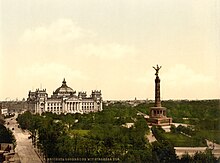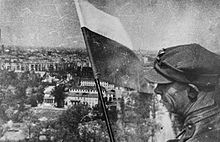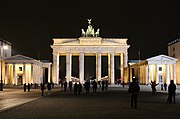Berlin Victory Column

| Coordinates | 52°30′52″N 13°21′0″E / 52.51444°N 13.35000°ECoordinates: 52°30′52″N 13°21′0″E / 52.51444°N 13.35000°E |
|---|
The Victory Column (German: ![]() Siegessäule (help·info), from Sieg ‘victory’ + Säule ‘column’) is a monument in Berlin, Germany. Designed by Heinrich Strack after 1864 to commemorate the Prussian victory in the Second Schleswig War, by the time it was inaugurated on 2 September 1873, Prussia had also defeated Austria and its German allies in the Austro-Prussian War (1866) and France in the Franco-Prussian War (1870–71), giving the statue a new purpose. Different from the original plans, these later victories in the unification wars inspired the addition of the bronze sculpture of Victoria, the Roman goddess of victory, 8.3 metres (27 ft) high and weighing 35 tonnes, designed by Friedrich Drake. Berliners have given the statue the nickname Goldelse, meaning something like "Golden Lizzy".[1]
Siegessäule (help·info), from Sieg ‘victory’ + Säule ‘column’) is a monument in Berlin, Germany. Designed by Heinrich Strack after 1864 to commemorate the Prussian victory in the Second Schleswig War, by the time it was inaugurated on 2 September 1873, Prussia had also defeated Austria and its German allies in the Austro-Prussian War (1866) and France in the Franco-Prussian War (1870–71), giving the statue a new purpose. Different from the original plans, these later victories in the unification wars inspired the addition of the bronze sculpture of Victoria, the Roman goddess of victory, 8.3 metres (27 ft) high and weighing 35 tonnes, designed by Friedrich Drake. Berliners have given the statue the nickname Goldelse, meaning something like "Golden Lizzy".[1]
The Victory Column is a major tourist attraction in the city of Berlin. Its viewing platform, for which a ticket is required, offers a view over Berlin.
History, design, and influences[]
This section does not cite any sources. (April 2017) |
Design and dimensions[]
Built on a base of polished red granite, the column sits on a hall of pillars with a glass mosaic designed by Anton von Werner.
The column itself, designed by Heinrich Strack and inspired by the "lighthouse of Brescia" which stands in the Cimitero Vantiniano, the monumental cemetery of Brescia, consists of four solid blocks of sandstone, three of which are decorated by cannon barrels captured from the enemies of the aforementioned three wars. A fourth ring is decorated with golden garlands and was added in 1938–39 when the whole monument was relocated to its present position. The entire column, including the sculpture, is 67 metres (220 ft) tall.
Designers and architects[]
Werner designed the original hall of pillars with a glass mosaic.
The foundation is decorated with four bronze reliefs showing the three wars and the victorious marching of the troops into Berlin. They were created by:
- Moritz Schulz (1825–1904)
- (1838–89)
- Alexander Calandrelli (1834–1903)
- and Albert Wolff (1814–92)
The relief decoration was removed in 1945. It was restored for the 750th anniversary of Berlin in 1987 by the French president at that time, François Mitterrand.

Location and relocations[]


The Victory Column originally stood in Königsplatz (now Platz der Republik), at the end of the Siegesallee (Victory Avenue). In 1939, as part of the preparation of the monumental plans to redesign Berlin into Welthauptstadt Germania, the Nazis relocated the column to its present site at the Großer Stern (Great Star), a large intersection on the city axis that leads from the former Berliner Stadtschloss (Berlin City Palace) through the Brandenburg Gate to the western parts of the city.
At the same time, the column was augmented by another 7.5 metres, giving it its present height of 66.89 metres. The monument survived World War II without much damage. The relocation of the monument probably saved it from destruction, as its old site – in front of the Reichstag, at exactly 1,500 metres (one Roman mile) from the proposed new north-south triumphal way of the Nazis in line with the Imperial Victory Avenue in the Tiergarten – was destroyed by American air raids in 1945.
Surrounded by a street circle, the column is also accessible to pedestrians through four tunnels, built in 1941 to plans by Albert Speer who likewise increased the width of the road between it and the Brandenburg Gate and designed the new Germania which was scheduled for construction after the victory obtained in the war. Via a steep spiral staircase of 281 steps, the physically fit may, for a fee, climb almost to the top of the column, to just under the statue and take in the views over the Tiergarten including the Soviet War Memorial, 1946, in line with the Nazi proposed north-south triumphal way by Speer and Adolf Hitler.
Historical significance[]
"El Ángel", built in 1910 in Mexico City, bears a more than passing resemblance to the Berlin victory column, while both echo the earlier examples of the victory column crowned by an angel, notably the Alexander Column in Saint Petersburg.
During the Battle of Berlin of 1945, Soviet Troops nicknamed the column "the Tall Woman".[2] Polish Army troops, fighting alongside their Soviet allies, hoisted the Polish flag on the column on 2 May 1945 at the end of the Battle in Berlin.

During the allied victory parade in 1945, the French tricolor was raised atop the column on the statue by French troops.[3]

It served as the location for Barack Obama's speech in Berlin as a US presidential candidate during his visit to Germany on 24 July 2008.[4][5]
In popular culture[]
The golden statue atop the column, cast in 1873 by the Aktien-Gesellschaft Gladenbeck foundry in Berlin,[6][7] was featured in the music video to U2's 1993 "Stay (Faraway, So Close!)".
In Wim Wenders' Wings of Desire (1987), the column is one of many such high places in the city where angels sit and look down.[8]
During the years of the techno Love Parade, the column was a meeting point where large numbers of people danced together.[9]
The Berlin queer monthly magazine Siegessäule was named after the monument, founded 1984 as a gay publication.[10][11] The Berlin Pride (CSD parade) usually includes the column on its route for the symbolism.[12]
See also[]
References[]
- ^ Berlin Tourist Information - Tiergarten Archived 22 June 2008 at the Wayback Machine
- ^ Beevor, A (2003), Berlin: The Downfall 1945, Penguin Books, p. 395
- ^ ECPAD - Troupes françaises défilant à Berlin
- ^ Whitesides, John (25 July 2008). "Obama's foreign trip: Mission accomplished". Reuters.
- ^ Borcholte, Andreas (20 July 2008), "Sieg der Säule", Spiegel
- ^ "Biography: Hermann Gladenbeck (1827-1918)". toboganantiques.com. Archived from the original on 18 June 2015. Retrieved 18 June 2015.
- ^ "Oscar Gladenbeck (1850-1921)". ISSUU.com. Retrieved 18 June 2015.
- ^ Nachrichten, BerlinOnline.de, 2012, archived from the original on 15 August 2009, retrieved 26 July 2008
- ^ Berlin Life: 'The Death of Dance?' A history of the Berlin Love Parade, Berlin-Life.com, 2007, retrieved 21 July 2020
- ^ "Die "Siegessäule" wird 30".
- ^ TBS-Monatsinfo (Treff Berliner Schwulengruppen) (10 February 1984). "Gemeinsames". Record of TBS: Top 12 – via Archiv Gay Museum Berlin.
- ^ "Demo | Route 2019".
External links[]
| Wikimedia Commons has media related to Berlin Victory Column. |
- 1873 sculptures
- Buildings and structures in Mitte
- Monumental columns in Germany
- Monuments and memorials in Berlin
- Terminating vistas in Germany
- Victory monuments
- Tiergarten (park)
- Sculptures of Victoria (mythology)

